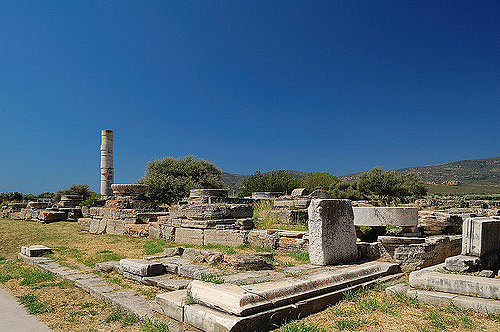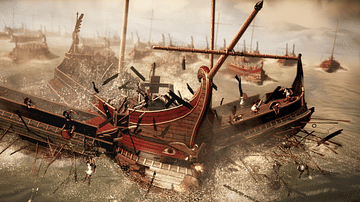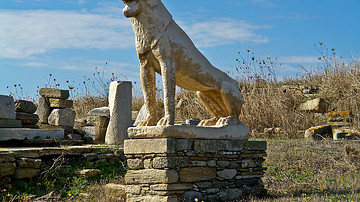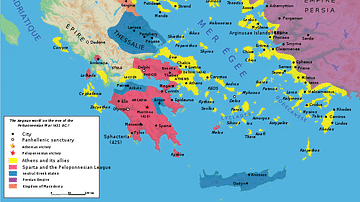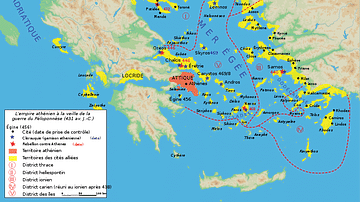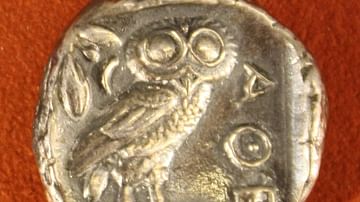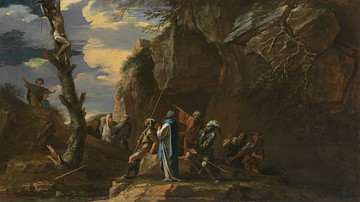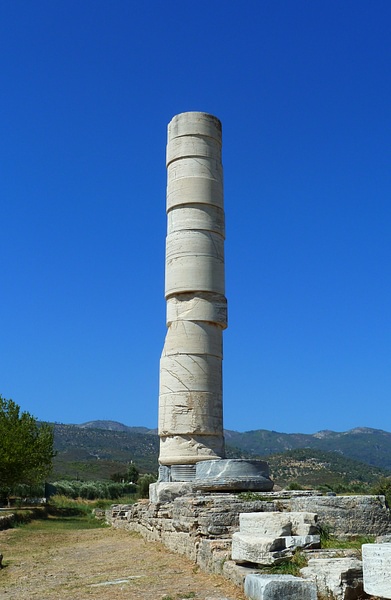
Samos is a Greek island in the east Aegean, just off the coast of modern-day Turkey. It particularly flourished in the 6th century BCE and was famous in antiquity for its navy, wine, and important sanctuary to Hera. Samos was an active member of the Delian League and the celebrated philosopher and mathematician Pythagoras was born there, as was the famed astronomer Aristarchus. Hosting both Julius Caesar and Mark Antony in the 1st century BCE, the island then slipped quietly into obscurity during the Roman imperial period. Samos is listed by UNESCO as a World Heritage Site.
Early Settlement
Samos was first occupied in the Neolithic period, and a late Bronze Age presence is attested by Mycenaean remains. Carians followed next in the 10th century BCE. The Greeks themselves recorded that in the Archaic period colonists arrived from Ionia. According to Thucydides those settlers themselves had originally come from Attica. A city was founded in the south-east of the island as Samos benefitted from arable mountain slopes and fertile plains. Wine and olive oil were exported and transported in amphorae distinctive to the island. The island's prosperity is further evidenced by the monumental stone architecture constructed from the 8th century BCE. The famed sanctuary of Hera (Heraion), built in honour of the island's patron during the reign of the tyrant Aeaces, was located 8 km from the main city.
From the 7th century BCE, Samos maintained a naval fleet with help from its ally Corinth. The ships were built using wood from its thick forests. This navy, one of the largest in Greece, would eventually be composed of the famous trireme warships which had three banks of rowers and a bronze battering ram on the prow. As the island prospered so it participated in the general wave of Greek colonization. Samos established colonies in Cilicia, the Propontis, and the Black Sea. In northern Africa, the island also co-founded Cyrene and built a temple at Naucratis.
Polycrates the Tyrant
During the reign of Aeaces' son, Polycrates (c. 535-522 BCE), Samos particularly flourished, controlling that part of the Aegean and the Cyclades with its 100 warships and the help of its Egyptian ally Ahmose II. The city also gained a reputation as a cultural centre, attracting poets such as Anacreon and Ibycus, and was home to the famous architect Theodorus. At this time, Samos benefitted from an enlarged temple to Hera (the largest ever according to Herodotus), a 365 m long harbor mole, and fortifications. A tyrant is perhaps always a tyrant though (even in the Greek sense), and the famous philosopher and mathematician Pythagoras was one who felt compelled to leave Samos. In 522 BCE, as Persia took a greater interest in the region, the island was taken over by the Persian satrap Oroites and Polycrates was crucified. Things did not improve during the Ionian Revolt when those states attempted to break free of Persian rule. Samos was defeated at the battle of Lade in 494 BCE and, according to Herodotus, many of the island's elite fled to Sicily.
The Delian League
In 478 BCE Samos became a member of the Delian League. As the League gradually transformed into the Athenian empire and members were compelled to pay tribute, some sought to leave and Samos was one such disaffected city-state in the 440's BCE. However, Athens, at the time led by Pericles, besieged the island c. 440 BCE and forced Samos to remain, extracting a significant fine from the island. From that time on Samos had a pro-Athenian elite running the government and the island became one of the most important League members, supporting Athens throughout the Peloponnesian War. Alcibiades, for example, made a base of Samos in 407 BCE. The people of Samos were even given the privilege of Athenian citizenship in 405 BCE and there was a brief system of democracy. When Sparta won the war, the city claimed control of Samos with the establishment of a rule of ten pro-Spartan oligarchs set up by Lysander. In 366 BCE Athens won the island back and exiled a large portion of the population.
Hellenistic & Roman Periods
In 322 BCE, at the end of the Lamian War between Macedon and a Greek coalition led by Athens, the island became independent. Catching the eye of several rulers during the Successor Wars, Samos eventually came under the control of the Ptolemies of Egypt from 281 BCE. There followed a period of re-building of both the city and the Heraion. As so often, with political stability came cultural endeavor, and the famous astronomer Aristarchus formed his influential theories. From 246 BCE a Ptolemaic fleet used Samos as a permanent base. In 205 BCE the island was taken over by Philip V of Macedon, lost again and re-taken in 201 BCE before returning to the Ptolemies. From 197 BCE Samos came under the jurisdiction of Rhodes.
After supporting the Romans in their wars against Antiochus, the island was given its independence in 188 BCE. In 129 BCE the island became part of the Roman province of Asia. A century of prosperity was brought to an end in 39 BCE when Mark Antony sacked the island; both he and Caesar used the island as a base during the civil wars that ended the Roman Republic. Emperor Augustus made Samos a free city again, but independence lasted only for a century until the reign of Vespasian. Even if the Romans brought benefits such as public baths and basilicas, Samos was now a provincial back-water. It became part of the provincial insularum group of Aegean islands during the reign of Diocletian, and finally, in the Byzantine period, it came under the jurisdiction of the Cyclades.
The Heraion
The cult of Hera on Samos dates back to Mycenaean times when a stone altar was set up in honour of the goddess. Hera was the patron of Samos, and in Greek mythology she was born there, daughter of Cronus and Rhea. The site became more grandiose over the next few centuries until the first substantial temple was built in the sacred complex known as the Heraion. This temple was one of the earliest in Greece to use stone. The 7th century BCE saw more additions and a wooden wall enclosed the site. In 570-560 BCE an all new limestone temple, much larger than its predecessor, was constructed by two noted architects, Rhoikos and Theodoros. Measuring 52.5 x 100 metres and with columns 18 metres high, it had a wooden entablature and tiled roof. Unfortunately, only a few years after its completion, the temple was destroyed by an earthquake.
A new temple was built during the reign of Polycrates (although perhaps never fully completed), slightly larger than before, measuring 55 x 108 metres. It had 20 metre high columns on all four sides, 155 in total. The temple was built using limestone but, this time, the columns were carved in marble. One lone column still stands at the site today. The place of ritual was a massive rectangular altar placed outside the temple measuring 36.5 x 16.5 metres. The limestone altar was surrounded by a wall, up to 7 metres in height, which carried relief scenes depicting animals and sphinxes. In the Roman period the altar was replaced by a marble version, and in the 2nd century CE a small temple was added to the site (7.4 x 12 metres), dedicated to an unknown deity. In the 3rd century CE another temple was added and the sacred way, which led to the city proper, was paved. Gradually, as the cult of Hera declined, the site was encroached upon by private houses and villas. The Heraion was destroyed by an earthquake in 262 CE and shortly after was sacked by Germanic tribes. A brief revival occurred in the 5th century CE when a basilica was built at the site, which had three aisles and which recycled material from the earlier buildings.
Archaeological Remains
Samos has several other architectural features of interest. The first is the 1 km long tunnel constructed by Eupalinus of Megara in the 6th century BCE, which functioned as an aqueduct and carried water to the city. The mole built by Polycrates survives, as do parts of the fortifications built in the same period. Areas of the city have been excavated revealing paved roads, drainage systems, large villas with mosaic floors, shops, and ordinary housing. A large mid-6th-century BCE kouros (naked male youth) statue has also been recovered from the site along with several other large votive statues. These are presently housed in the on-site archaeological museum.

